Structural Predictions: Part One
 Derek & Laura Cabrera
·
8 minute read
Derek & Laura Cabrera
·
8 minute read
Excerpt from the book: Systems Thinking Made Simple, Chapter 6
PREDICTIVE POWER OF SIMPLE RULES
The ultimate goal of all science is to understand the intricacies of the universe well enoughto make predictions of what will occur.
Prediction: if you smoke, you will greatly increase your odds of getting cancer. Prediction: the force will equal the mass times its acceleration.
DSRP rules also help us to make predictions about the structure our mental models (knowledge) will take, predictions about how we will think. For example, we can predict that if the two ideas in Figure 6.1 are located in the same conceptual space we'll try to relate them.

This prediction lies at the base of marketing, where we are constantly bombarded with free associations that benefit the manufacturer. We can effectively predict that you'll think yellow and fruit.
For example, we can predict to a profitable degree that children relate their favorite sports star (Ken Griffey, Jr., Reggie Jackson, or Nolan Ryan) with Frosted Flakes cereal (a spurious relationship). And large marketing budgets have been expended to associate fat free with healthy (also a spurious relationship), so by triangulation: fat free = healthy, frosted fakes = fat free, therefore frosted fakes = healthy. That's all that kids and moms need to make the purchase and begin the morning with a transfusion of 21 grams of sugar per bowl.
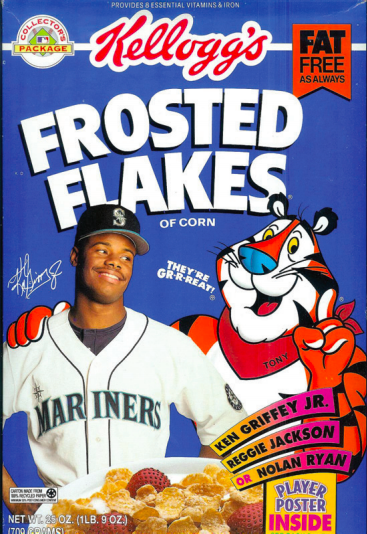
Coca Cola has engaged us all in a decades-long campaign to create an ecology of interrelated ideas that lead us to believe that a Coke should be enjoyed during all of life's moments. Despite the fact that Coke actually leads to an early death, 1 Coke is spending hundreds of millions to ensure that children grow up believing that Coke and life are intertwined. They've also ensured that you'll draw a relationship between Coca Cola products and: Santa Claus, happiness, the United States of America, and friendship seen in Figure 6.3. That's the power of prediction based on your mind’s natural processes.
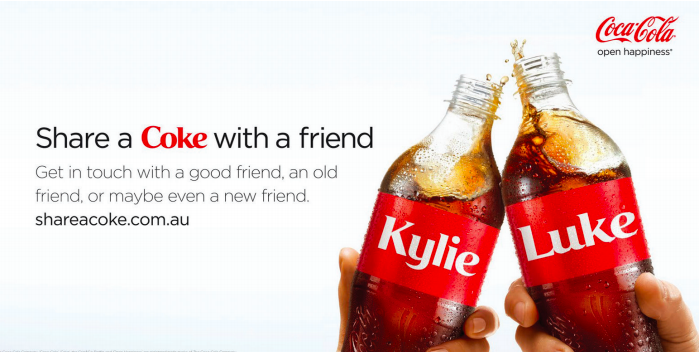
Marketers and political operatives know that if they cause the general public to make any given relationship enough times many will continue to make it even when it’s not being made for them. Eventually, the relationship between two distinct things or ideas soon merges into a single system—a new thing/idea comprised of the interrelated parts. The word “is” is the third person singular present form of the verb to be. To be is an existential idea—it gets at the very essence of something. These manipulations are intended to mess with our distinctions. Frosted Flakes is healthy. Coca Cola is life. Obama is Osama.
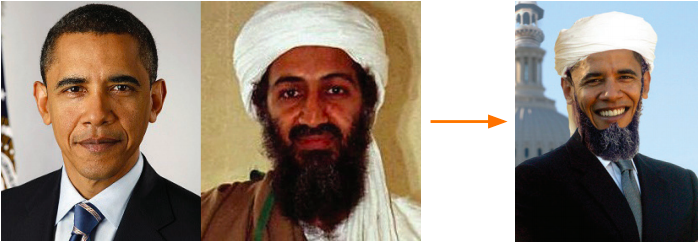
This rewiring of our most basic distinction-making is predictable. But prediction need not only be used for profit and manipulation. It can be a powerful inoculation against such manipulations. If we can predict the structure our own thinking will take, it can be used to discover new ideas.
Prediction in Knowledge Creation
One of our biggest systemic problems is that we are unable to keep up with the sheer number and magnitude of wicked problems we face. It seems life is speeding up with globalization. This means we need to create knowledge faster just to keep up with all our wicked problems. Nowhere is this more evident than in the fight to keep up with evolving superbugs (strains of bacteria that evolve to become resistant to our antibiotics), where the evolution of these bacteria is out-pacing the evolution of our knowledge about them. That means we need to not only create more knowledge (new discoveries), but create that knowledge faster. Up until recently, our knowledge creation industry (mostly scientific labs in universities and innovation labs in organizations) has kept up with the demand reasonably well. But as demand increases, supply is hampered by three factors: (1) a lack of understanding of how knowledge is created, (2) over-focus on informational content, and (3) inability to be interdisciplinary.
In Chapter 4 we discussed that meaning comes from the interaction of information content and DSRP structure. Let’s look at a very simple example in Figure 6.5 using just a few words. We can think of the words themselves as information content and any shapes or lines as being the structure, so in the image below, the words Jump, Dog, and The are bits of information. The only structure they have thus far is that they are distinctly different because they are different cards. Notice that, thus far, there is very little meaning being created because we haven’t structured this information. Sure, we know what the words themselves mean from prior knowledge, but we have no idea what the meaning of the words are here together in this context.

Now, let’s add some structure, as seen in Figure 6.6. You can see that by simply putting the three distinct ideas in a row and relating them, we get, “Jump The Dog.” We now have some meaning being made. Apparently there is a dog and someone is giving a command to jump over it.

But if we change the organization or structure, we get a very different meaning. In Figure 6.7 we see the configuration: “The Dog Jump.” Forced to make meaning out of this and only this structure, we might come to the conclusion that there’s a cool jumping ramp for dogs, or something like that.

The point of this simple example is to help you differentiate between information and structure. The structure is all the cards and lines, and the information is the words themselves. Structuring information is what thinking is. Thinking is a process of structuring information in order to give it meaning. So if you take the same information but structure it differently, you’ll get different meaning. Likewise, if you take the same structure, but put in different information, you’ll get different meaning.
What DSRP does, using a form of metacognitive mapping which we can best exemplify through Plectica software, is to show you all the possible ways the information you are working with could be structured. You may choose not to structure it in some of the ways that the DSRP and the software suggest, but you could. When you do follow the predictive power of metacognitive mapping using DSRP, you’ll find that you are able to create new meaning and garner new insights about whatever it is you’re thinking.
In addition, because DSRP (and Plectica software) predict using patterns of thinking that are universal, it naturally guides you to thinking that is more complex, more robust, more complete, and more systemic. That is why DSRP is referred to as systems thinking.
Interdisciplinary is important because wicked problems do not respect disciplinary boundaries. So our old disciplinary approach—where a physicist solves physics problems and a biologist solves biological problems and an economist solves economic problems—won’t do. Problems don’t say to themselves, “I’m just an economic problem, I’m not going to mess around in engineering or chemistry or biology.” Our lack of understanding of how knowledge is created is deeply rooted in our excessive focus on and allegiance to informational content over cognitive structure. All three of these problems of knowledge creation can benefit from application of DSRP simple rules.
Let me give you two examples that come from different types of knowledge creation. The first is the knowledge creation of an individual group of first graders. Of course, the knowledge they are creating isn’t new knowledge in the sense that it's not new to society as a whole, but it's new to those kids. The second example is new knowledge, globally speaking: the discovery of something completely new and groundbreaking. Both examples will illustrate why recognizing the often hidden structure of DSRP rules is so important to the process of creating new knowledge.
A first-grade teacher we worked with committed to teaching her students just one of the simple rules: part-whole. She did a short five-minute lesson where she explained that “everything can have parts and the parts can have parts.” She played a few fun games and led the kids in song about “parts and parts and parts.”
She then had the kids do what she had done every year for five years: go out into the parking lot and meet some firemen and see their firetruck. After the field trip, the kids drew and labeled pictures of their firetrucks and built a firetruck (they can sit in) out of cardboard boxes, paint, and other stuff. What this teacher found was that with just a five minute lesson on one of the universal structures (Systems Rule or part-whole) the kids drew more detailed firetrucks, they used more vocabulary words to describe their firetrucks, and they built a more sophisticated cardboard firetruck with more parts and distinctions! An example is shown in Figure 6.8.
The teacher explained that in previous years, where a pre-lesson on part-whole was not included, children’s drawings included far fewer parts, usually the basics like front, back, steering wheel, ladder, and tires (see Figure 6.9).
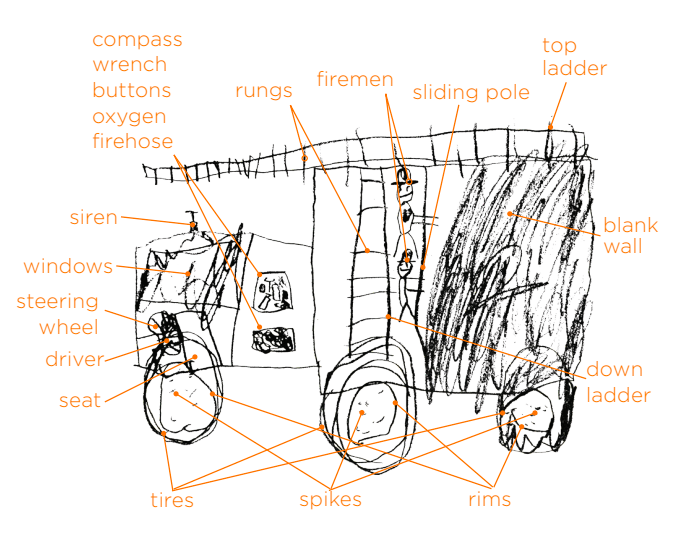
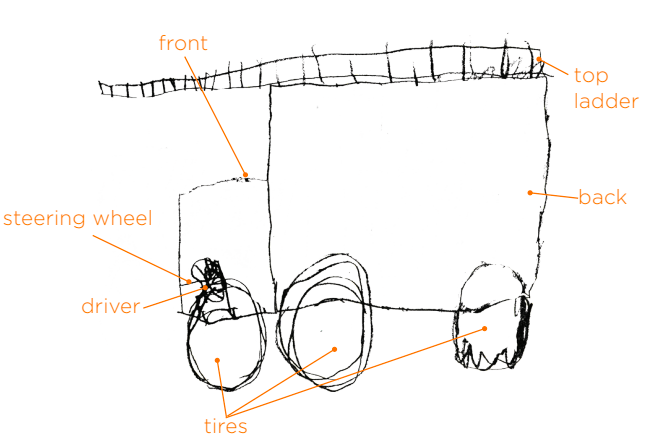
Later that semester, the same kids sent us a note (we had visited their classroom several times during the study) describing how they went on a field trip to an apple orchard. While there, they started thinking about all the parts of an apple and discovered one that they didn’t have a word for. Maybe no one had a word for the little fuzzy part, they thought. Maybe no one has even discovered ever before the little fuzzy part! They wanted to know if we, as scientists, knew if it had ever been discovered. And, in case it hadn’t been, they had a suggested name: the apple’s bellybutton. We let them know that it had already been discovered. After their initial disappointment, they proudly began using the term calyx in sentences.
A month later in the semester, the school went into lockdown mode because of something that happened in the wider community. For first graders, experiencing a lock-down for the first time can be a traumatic and worrisome experience. After it was over, a little girl asked her teacher, “Ms. Ward, can we part-whole the lock-down?” The whole class made a part-whole diagram of the lock-down to better understand what had just happened.
What’s remarkable is that these kids, without anyone asking them to, accomplished what educational scientists call far transfer. Far transfer means that when you learn something in one domain, you can transfer it to another domain and use it there. The term far refers to the degree of relatedness of the domains. Far transfer means that when someone teaches a student one thing, they can teach themselves 5, 10, or 20 things. What’s truly remarkable is that firetrucks, apples, and lock-downs have very little in common from an information-content perspective, but structurally, they were similar for these kids, and they knew it. The point is this: what transferred for these kids was not the content of the lessons (firetrucks, apples, lock-downs) but the structure (part-whole).
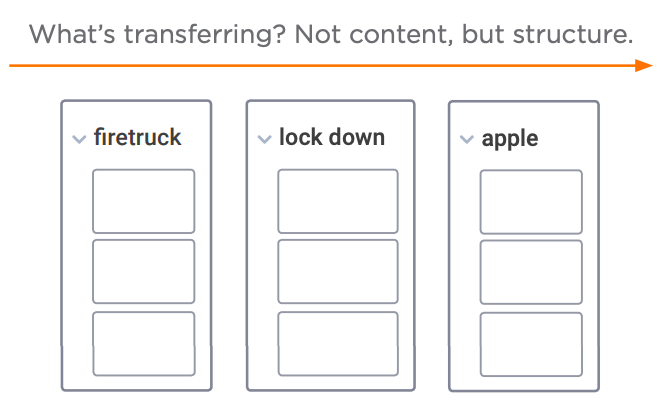
That’s all well and good for gradeschoolers, but what about knowledge creation for society as a whole? Charles Darwin took two books with him on his famous voyage on the Beagle. One was the Bible and the other was Sir Charles Lyell’s Principles of Geology. The latter was instrumental for Darwin in discovering his profoundly important ideas about evolution.
Darwin saw a structural analogy between geological and biological uniformitarianism. The content of what Darwin read in Lyell’s book (geological stratification) was substantively unlike the things Darwin was considering (biological speciation), but the underlying structure was, to Darwin’s mind, very similar. Here again, we see the immense importance of cognitive structure in the formulation of new knowledge. Time and time again, great inventions and innovations are the product of this structural awareness rather than informational content.
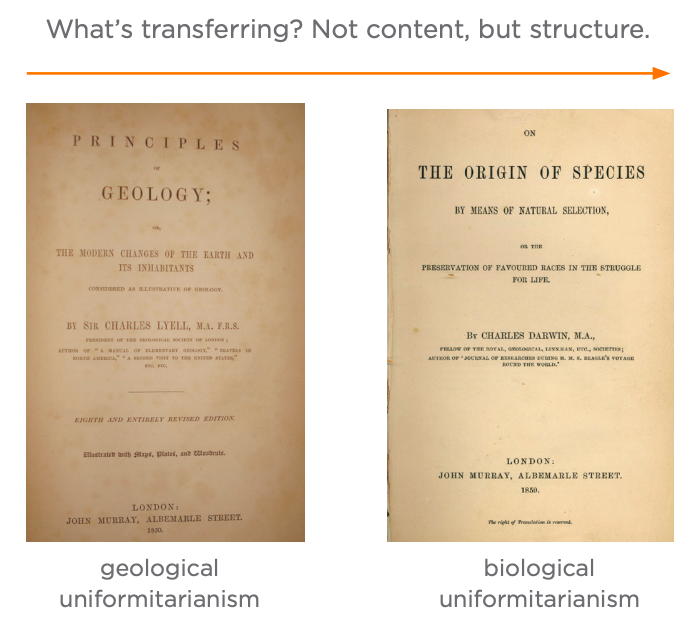
Remember from Chapter 4 that many traditional mapping techniques emphasize informational content over structure. In contrast, DSRP maps emphasize the structure that brings meaning to information. Knowledge discovery in the future may very well be reliant on the big data created by these globally shared DSRP maps that show us where new knowledge can be discovered based on structure, not on substantive content.
The University of California at San Diego's (UCSD) Map of Science (Figure 6.12) illustrates the analysis of 7.2 million papers (sourced from Web of Science and Scopus) using author citation networks across 13 sub-disciplines. David McConville of the Buckminster Fuller Institute explains: “The radical fragmentation of knowledge is making it difficult to understand any kind of big picture. Academia now has 8,000 disciplines, 50,000 journals, and over a million articles published every year. A visualization from the University of California–San Diego shows how few disciplines actually draw from, or even reference, fields other than their own. We are facing a time of extreme hyper-specialization.”
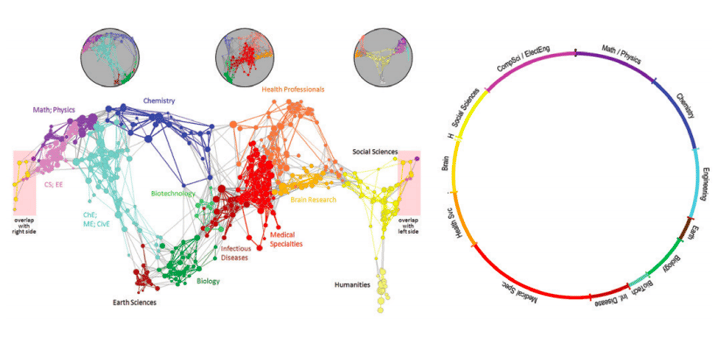
This lack of interdisciplinary equates to a lack of innovation in science. The kinds of profound insights had by Darwin and children alike come when disciplines intermingle and underlying structures are explicated. Systems thinking and interdisciplinary are synonymous sister acts in moving toward a new science. This new science is based on DSRP structures because it is: boundary crossing (D), reductionistic and holistic (S), interconnected and relational (R), and hyper-perspectival (P).
Simple DSRP rules lie at the base of much of what we need in order to build interdisciplinary knowledge faster and better and ward of the wicked problems of tomorrow, because they:
- Give us a modeling language for understanding how knowledge is created;
- Reduce excessive focus on informational content by balancing it with cognitive structure;
- Increase interdisciplinarity and transfer;
- Give elite scientists with highly specialized terminology a common language; and
- Provide predictive analytics that allow scientists to “mine for insights” in the most probable places.
.png?width=150&height=150&name=CRL%20GOAT%20Logo%20(4).png)


